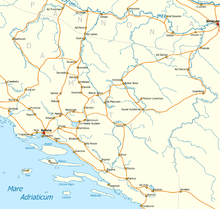Early history of Bosnia and Herzegovina
Within the boundaries of today's Bosnia and Herzegovina, there have been many layers of prehistoric cultures whose creation and disappearance are linked to migrations of unidentified ethnic groups.
Herzegovina was under the influence of impresso ceramics from the western Mediterranean, as seen in Green Cave near Mostar, Čairi near Stolac, Lisičići near Konjic and Peć Mlini near Grude.
Due to these objects, Kakanj culture is considered a part of the wide circle of Neolithic populations that followed a cult of life force (from northern Italy, Dalmatia and Epirus to the Aegean).
The Butmir culture near Sarajevo is distinctive, with fine glazed ceramics and miscellaneous geometrical decorations (often spirals).
Figures from Butmir are unique sculptures modeled with hand; heads are almost like portraits with emphasized parts of body.
Bronze Age settlements in Herzegovina were built like citadels (natively called gradina), and in Bosnia we have necropolises with stone tumuli.
In northern parts, there was a long tradition of cremation and burial in shallow graves, while in the south the dead were buried in large stone or earth tumuli (natively called gromile) that in Herzegovina were reaching monumental sizes, more than 50 m wide and 5 m high.
Concrete historical evidence for this period is scarce, but overall it appears that the region was populated by a number of different peoples speaking distinct languages.
In the year 10 A.D., Illyria was divided and the northern strip of today's Bosnia along the south side of the Sava River became part of the new province of Pannonia.
[2] Christianity had already arrived in the region by the end of the 1st century, and numerous artifacts and objects from the time testify to this.



